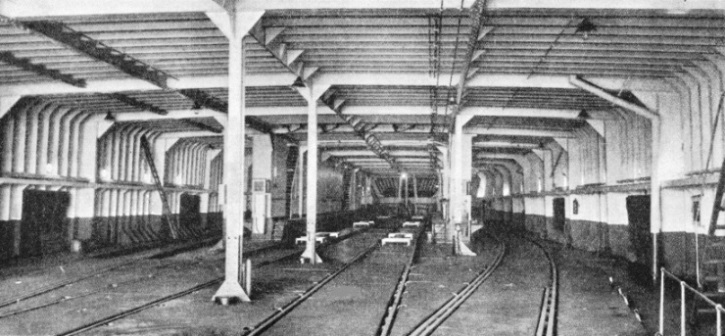

© Shipping Wonders of the World 2024 | Contents | Site Map | Contact Us | Cookie Policy

Dover-Dunkirk Train Ferry
Railway communications between Great Britain and the continent have been much facilitated by the train ferry across the English Channel between Dover and Dunkirk. For the first time, passengers are able to travel to or from the Continent without changing trains.
FOUR RAILWAY TRACKS occupy the main deck of the Dover-
FROM a passenger’s point of view, especially on such a journey as that from London to Paris, the English Channel is an annoying strip of water. The journey, whether it lasts all day or all night, is broken up into restless spells.
The run from Victoria Station, London, to Dover is too short to allow any one to settle down in the train. The crossing from Dover to Calais is shorter still, and from a landsman’s point of view is the worst crossing of all. The railway journey from Calais to Paris gives one a little more time to relax, but by then, especially in bad weather, many passengers have had their fill of exasperating changes and the miseries of sea-
With goods transport by the normal route, the difficulties of double transhipment and the resultant expenses are serious. Through transit has been provided for some time, however, by the tidal train ferry between Harwich and Zeebrugge. Where freight is concerned, therefore, the Dover-
The Harwich goods train ferries have been operating since 1924, and more than a quarter of a century has elapsed since passenger train ferries began to ply between Sassnitz in Germany and Tralleborg in Sweden. In the Baltic the tides are negligible, but in the English Channel there is a great difference between high and low water mark. Tides that come sweeping up through the narrow Strait of Dover have all the force of the Atlantic behind them. At Dover the maximum difference between high and low water is 25 feet. Such a difference is particularly serious where train ferry berths are involved.
Connexion between the railway tracks on land and those on the train deck of a ferry steamer is normally effected by means of a drawbridge. This works perfectly well with the large sea-
Perfect steadiness is necessary for the running of railway or road vehicles directly on to the decks of a ferry steamer. If a drawbridge alone were used for this purpose at Dover or Dunkirk, a length of 500 feet would be necessary. The ferry berth and the railway drawbridge were therefore placed within a large enclosed dock. The quantity of water in this dock could be varied and brought to the right level by powerful pumps, irrespective of the state of the tide. The dock thus resembled the sea-
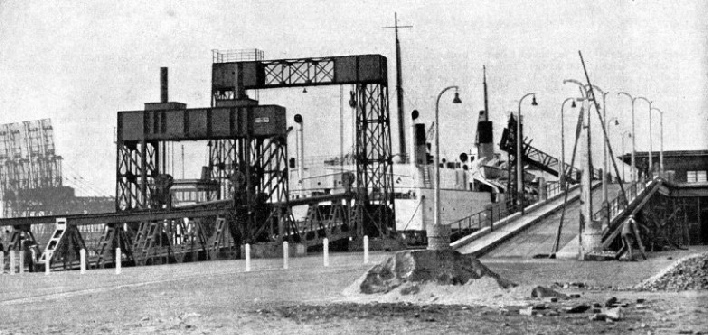
A BROAD CONCRETE RAMP leads to the gangway across which all motor vehicles, with the exception of heavy lorries, board the upper deck of the Dover-
The engineers met with difficulties at first, for nothing of its kind had been attempted before. The great destructive strength of a Channel gale in midwinter was underestimated. Work was started by the building of walls round the site of the dock. These walls were to consist of piles driven into the chalk foundation, strengthened by cross walls and filled in with earth. The piles themselves were built of sheet steel. Some progress had been made in the building of these walls when winter set-
A fresh start was made by surrounding the site with 25-
When the time came for the water to be pumped out, it was found that water from outside percolated through the chalk forming the bottom of the harbour faster than any appliances could possibly pump it out. The chalk was full of fissures and not impervious to water.
An attempt was made to stop the percolation by plastering the outsides of the concrete walls with mud. But even this was in vain. The water continued to pour in more rapidly than it could be pumped out, and work seemed to be at a standstill. The area of the nascent dock was 414 feet long by 70 feet wide, and the depth of the water over the dock sill at extreme low tide was to be 17 feet.
An entirely new and untried plan had to be evolved and put into practice. The dock was to be built without excluding the water, and in rough winter weather the work, as it progressed, was as difficult as that of building a dock in the open sea.
300-
In such conditions as these, Mr. George Ellson, the Chief Engineer of the Southern Railway Company, carried out his formidable task. The effect of swell was reduced by placing a temporary caisson across the mouth of the dock area. Inside, a powerful dredger was used to excavate the chalk bottom to the required depth and evenness. Eventually this was covered by a bed of concrete 5 feet thick, laid, under water. Divers levelled it off in strips 80 feet by 25 feet. This, however, was one of the last phases in the construction of the dock.
The laying of the dock sill and the two water gates dependent on it presented more difficulties. Each gate, weighing 300 tons, was to work on horizontal hinges fixed below the dock sill. In the “open” position, both gates would thus lie flat on the bottom, completely hidden from view and well below the dock sill. To make this possible, a steel pontoon was built on land, with the huge gate hinges on its base. The pontoon was then placed in the water and sunk across the entrance to the dock. The sinking was effected between guides carefully spaced to ensure accuracy. The pontoon weighed approximately 400 tons. When placed in position, the pontoon was within 1 in. of its correct position and perfectly level. It was a triumph for the surveyor and for the structural engineer, as well as for the workmen, above and under water, who handled this immense task. Once the pontoon was down and filled with concrete, sinking the gates and securing them to the hinges below the sill was a relatively simple matter.
Another difficult piece of work was the installation of the pumping machinery. The pumps had to be placed some distance below extreme low water level, and the pumping chamber had to be built under water.
As the dimensions of the pumping chamber were 102 feet long and 40 feet wide, with the lowest floor level 50 feet below high water mark, this promised to be as formidable a task as the sinking of the dock sill. The floor was composed of concrete blocks lowered into the water and placed in position by the divers. After the side walls had been completed, the chamber was cleared of water and the culverts connecting the dock with the sea outside were built. The finished pumping chamber contains three sets of centrifugal pumps, with a maximum capacity of 123,000 gallons of water a minute. Outside the dock extends a 400-
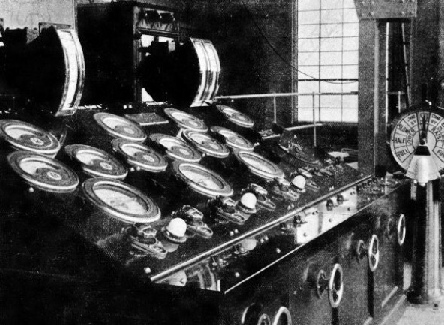
THE PUMP CONTROLS AT DOVER operate three sets of centrifugal pumps, which have a maximum capacity of 120,000 gallons a minute. The installation of the pumps was a matter of great difficulty. They had to be placed some distance below extreme low water level. The pumping chamber is 102 feet long and 40 feet wide.
Once the vessel has entered, stern first, the gates are closed, and the ship is brought up or down to the required level, according to the state of the tide. When the train deck is on the same level as the railway tracks on land, an adjustable bridge carrying two rail tracks is lowered to connect with the ship’s stern. This bridge is 70 feet long, and is articulated to allow for such lateral tilting as inevitably takes place when vehicles are being run on board. It holds fast to the ship by a socket which fits over a steel pin fitted in the stern. Road vehicles, with the exception of heavy lorries, reach the vessel by being driven up a long concrete ramp and across a simple broad gangway on to the upper deck, where garage accommodation is situated.
The docking difficulties met with in Dover Harbour did not arise at Dunkirk, where there are extensive docks. There the only special need was met by the provision of the adjustable bridge and motor ramps.
Special ferry steamers have been built to the order of the Southern Railway Company for this service. There are three of them, sister ships, named after well-
Great Britain was the pioneer of this class of vessel, although in past years train ferries have been commoner in foreign waters than on British coasts. The first train ferry in the world was the Leviathan, built and engined on the Clyde by Robert Napier and Sons in 1849, for the Burntisland-
Novel Deck Arrangement
She had a long life, and was used for ferrying trains across the Firth of Forth until 1890, when the completion of the Forth Bridge brought her occupation to an end. This once famous, though now almost forgotten pioneer, lasted until July 1892, when she was posted for breaking up.
On June 18, 1934, in the course of her trials, the Twickenham Ferry maintained a speed of 16½ knots at 189 revolutions a minute, and 17·8 knots at 205 revolutions. Her speed astern, at 172½ revolutions, was 11·8 knots. The weather was fine and the sea smooth, with a breeze of 11 to 12 knots blowing from south-
The constructional difficulties experienced in building the special dock at Dover were considerable, and the dock was finally completed much later than had been anticipated. The first task of the Twickenham Ferry, indeed, was undertaken a considerable time before the regular service was opened. This was to transport the cars and lorries belonging to the British troops sent to the Saar Valley, at the time of the Plebiscite in March 1935. One of the three ferry steamers was used as a grandstand at Southampton Docks when the Queen Mary set off on her maiden voyage in May 1936.
The train ferries are 364 ft. 9 in. long and 60 ft. 8 in. in beam and have a displacement of 3,980 tons. They are relatively flat bottomed and have a mean draught of 12 ft. 1½ in. Swan, Hunter and Wigham Richardson, Limited, the Tyneside firm which built one of the Swedish train ferries for the Sassnitz-
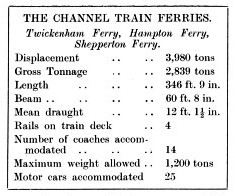 The engines are geared turbines built by the Parsons Marine Steam Turbine Company at Wallsend, Co. Durham. The boilers are of the well-
The engines are geared turbines built by the Parsons Marine Steam Turbine Company at Wallsend, Co. Durham. The boilers are of the well-
The two funnels are set transversely to avoid interference with the main deck, on which the railway tracks are situated. On the upper deck is a complete garage, with accommodation for twenty-
The maximum weight allowed on board is 1,200 tons. The sleeping cars used on the London-
On the train deck are two island platforms by which passengers may leave the cars during the crossing. An elaborate system of jacks and chains is provided on this deck. The jacks take the weight of the carriages off their own springs; the chains hold each vehicle firmly in position so that it remains immovable.
At the after end of either platform there are an engine hatch and a companion-
On the lower deck, forward of the boiler-
As rail and road vehicles are brought on board on their own wheels, hoisting gear is reduced to a minimum. There are two 3-
The three Dover-
ACCOMMODATION FOR TWELVE SLEEPING CARS and two luggage vans is provided in the Twickenham Ferry, the first of the three train ferries built for the Dover-
Specially Built Rolling Stock
The first of the three vessels, the Twickenham Ferry, has been handed over to the Angleterre-
By means of the Dover-
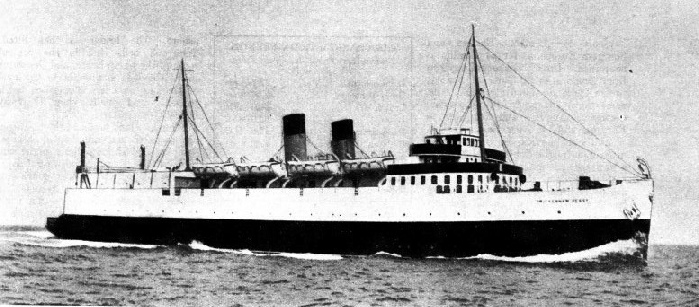
ACCOMMODATION FOR TWELVE SLEEPING CARS and two luggage vans is provided in the Twickenham Ferry, the first of the three train ferries built for the Dover-
A fascinating study is that of the possible future development of train ferry services between Great Britain and the Continent. The three existing Southern Railway vessels are really sufficient only for carrying on the present twice-
The new “Black Forest Express”, which is to be inaugurated between London and Basle via Karlsruhe during 1937 should be greatly benefited and popularized by a “no change” cross-
Additional services for the ferrying of loaded freight vehicles might with advantage be extended to Antwerp and Rotterdam, though as yet there are no facilities for dealing with train ferries at those ports. Some time ago there was a project afoot for the provision of a train ferry service running directly between England and Scandinavia.
The distance of this crossing is much too far to be suitable for a passenger train ferry, but for freight traffic it would be another matter. A great amount of dairy produce reaches England every day from Denmark. By means of ferry steamers running between Esbjerg and Dover, it would be possible for loaded wagons to run direct from the dairy farming districts of Jutland to the London markets without a single transhipment and without having to cross, successively, the German, Belgian and French frontiers. In the reverse direction, such facilities would provide a new and easy outlet for the marketing of Kent coal.
For the time being, however, we must watch the initial workings of the pioneer Dover-
To a spectator the most impressive thing about the departure of a train ferry from Dover is the entire lack of fuss or confusion. There is no hurry or loading at the last minute. The train arrives from London. It is divided, and shunted, section by section, on to the four tracks on the main deck. The bridge tilts slightly with the weight of the shunting engine. Most of the compartments in the long blue and silver cars are in darkness. The last of the vehicles is pushed on board, and the locomotive disappears into the darkness ashore. The bridge is then lifted. Telegraph bells ring in the control room of the pump-
Whistles sound here and there. Ropes are cast off and are hauled ashore, dripping and shining dimly under the glare of the quayside electric lamps. Dark blue-
A barely perceptible pulsating rhythm sends a tremor through the length and breadth of the outgoing ferry steamer. Slowly and surely her keel passes over the submerged dock sill and its gates. The jetty slips by and drops astern.
On the train deck within, the sleeping cars show no lights save in the corridors, where the brown-
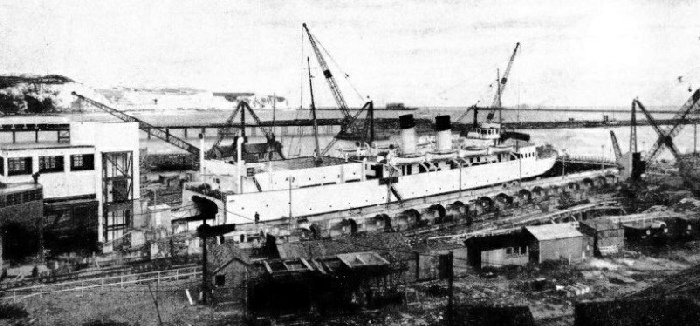
IN THE TIDAL DOCK AT DOVER the train ferry is raised or lowered to the level of the railway lines on the quay. When the train deck is at this level an adjustable bridge is fastened to the ship by a socket which fits over a steel pin fitted in the stern. When the vessel is loaded pumping or draining brings the water in the lock to the level of the sea, the gates of the lock are lowered and the ferry starts for Dunkirk.
You can read more on “The Lake Baikal”, “Train Ferry No. 3” and “The Twickenham Ferry” on this website.
You can read more on “Train Ferries” in Railway Wonders of the World
